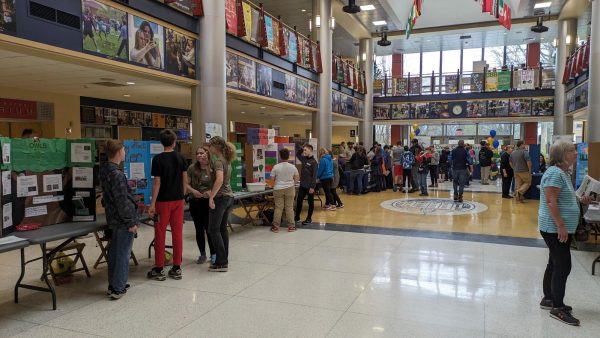Allegheny College’s dance and movement studies bring community members to campus
Tucked into a cozy office with two of her assistants, safe from the freezing temperatures of Meadville’s winter, Allegheny’s Dance and Movement Studies Instructor Betsy Sumerfield discussed the community dance lessons that allow Allegheny College and Meadville community members to warm up together.
Sumerfield, who has been working full-time at Allegheny for four years and part-time since 2000, began helping with the community lessons, which have been offered by the college for at least 10 years, before she took over as primary instructor. There are 10 lessons altogether, and the classes begin with the waltz then move to a dance chosen by participants.
Lessons focus on one dance for about two to three meetings, and the age range of participants varies from high school age to 80s, Sumerfield said. Two of the oldest participants, a married couple in their mid-80s, attended one of Sumerfield’s academic ballroom classes to demonstrate the swing dance for Allegheny students.
Although the number of participants varies from year to year, Sumerfield said she and her class always have fun, and she considers that to be a sign of their success.
“It’s fun to watch people come back (to the lesson) and go, ‘Oh, that’s what we were trying to do last time,’” Sumerfield said. “So that’s fun for me. Just getting to be in community is gratifying.”
Allegheny College Professor Scott Wissinger, partnered with his wife Sue Wissinger, has taken the dance classes multiple times. In a similar fashion to what Sumerfield described as her most gratifying moment, Scott said he struggles with the dances for a few sessions until his muscle memory begins to work.
“I really felt quite awkward the first time we did the waltz,” Scott said. “It was like I’d never done it before, and then about two sessions in, it was like ‘oh yeah, this is starting to come back.’”
As a dancer who helps participants with the dance while their muscle memory begins to work, Michaela Schlichtkrull, ’19, is beginning her second semester assisting in Sumerfield’s classes and lessons. Schlichtkrull is also a teaching assistant in Sumerfield’s Ballroom I classes.
“The most gratifying part (of the community lessons) is being around other people who are not on campus,” Schlichtkrull said. “It’s getting to see other people who are part of the community and who I wouldn’t normally see when I’m walking across campus.”
We feel more comfortable dancing, and we feel alive when we’re doing it.
— SCOTT WISSINGER Professor of biology and environmental science and sustainability, Allegheny College
During numerous lessons, Scott said he saw the creation of such relationships within the community.
“We’ve met some people through the class,” Scott said. “I have seen couples come into the class, not know each other, become friends because they were in that class, and then go do things together, including dance.”
Scott and Sue first became interested in the dance class because it offered a chance for them to spend time together outside of their busy schedules, Scott said. However, as they started dancing outside of the classes, they realized they were more comfortable dancing in public.
“It’s a relief from the day-to-day work schedule,” Scott said. “It allows us to have a scheduled together activity. And there’s this other benefit … it’s nice to be comfortable with having a choice of things to do to music, depending on the beat.”
During a trip to a scuba diving resort, Scott and Sue attended a dance party and, because of the community classes, were comfortable performing more complicated steps, such as the foxtrot, in front of others, according to Scott.
“We feel more comfortable dancing, and we feel alive when we’re doing it,” Scott said.
Both Sumerfield and Schlichtkrull agreed that teaching Allegheny classes and community lessons are entirely different experiences. Sumerfield said she teaches the academic classes and community lessons differently, which leads to a different attitude in participants that she and Schlichtkrull have observed.
“In the classes I teach for the students, there’s an academic component related to it, and they’re being graded, so it’s very important to me that they get the material the way they’re supposed to get the material,” Sumerfield said. “For the community class, the goal is to get them around the dance floor and be able to do it and have fun and show off a little bit. Ultimately, in Ballroom I, that’s also the goal, but because I have to put a grade on it, there’s more to it.”
Schlichtkrull said she sees a similar change in the level of stress from the Ballroom I classes to the community lessons.
“When the students are taking the class, they tend to be more stressed out at times, especially right before a test day,” Schlichtkrull said. “They end up losing a little bit of the dance … (Community lessons are) more about having fun with the dances and just enjoying it, and they’re not necessarily as focused on perfecting their move.”
Sumerfield echoed Schlichtkrull appreciation for how fun the community lessons can be.
“The participants get very serious about it, but not so serious that they don’t have fun,” Sumerfield said. “(It’s) just about how much we laugh.”
Lauren Trimber is a senior majoring in English and creative writing and minoring in political science. This is her third year on staff, and she will be...






